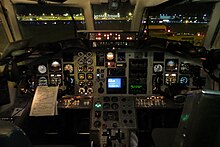Northwest Airlink was the brand name of Northwest Airlines' regional airline service, which flew turboprop and regional jet aircraft from Northwest's domestic hubs in Minneapolis, Detroit, and Memphis. Service was primarily to small-to-medium-sized cities and towns where larger aircraft might not be economical to operate and also to larger markets to either provide additional capacity or more frequent flights than could be justified using mainline aircraft. Beginning in July 2009, the Northwest Airlink trade name was phased out, and replaced by the Delta Connection trade name for Delta Air Lines as part of the Delta/Northwest merger.

Endeavor Air is a United States regional airline headquartered at the Minneapolis–Saint Paul International Airport in Minneapolis, Minnesota, United States. The airline is a wholly owned subsidiary of Delta Air Lines and staffs, operates and maintains aircraft used on Delta Connection flights that are scheduled, marketed and sold by Delta Air Lines.
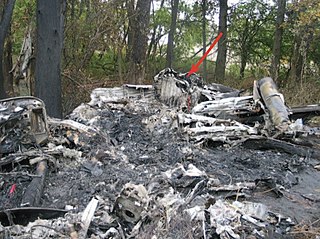
Corporate Airlines Flight 5966 was a scheduled passenger flight from St. Louis, Missouri to Kirksville, Missouri. On October 19, 2004, the Jetstream 32 aircraft operating the flight crashed on approach to Kirksville Regional Airport as a result of pilot error, killing 13 of the 15 people aboard.

United Airlines Flight 585 was a scheduled passenger flight on March 3, 1991, from Denver to Colorado Springs, Colorado, carrying 20 passengers and 5 crew members on board. The plane experienced a rudder hardover while on final approach to runway 35 at Colorado Springs Municipal Airport, causing the plane to roll over and enter an uncontrolled dive. All 25 people on board were killed.

Range Regional Airport is a public use airport located four nautical miles southeast of the central business district of Hibbing, in Saint Louis County, Minnesota, United States. It was formerly known as Chisholm-Hibbing Airport or Chisholm-Hibbing Municipal Airport. The airport is mostly used for general aviation but is also served by one commercial and one charter airline. Scheduled passenger service is subsidized by the Essential Air Service program.

Surinam Airways Flight 764 was an international scheduled passenger flight from Amsterdam Airport Schiphol in the Netherlands to Paramaribo-Zanderij International Airport in Suriname on a Surinam Airways DC-8-62. On Wednesday 7 June 1989, the flight crashed during approach to Paramaribo-Zanderij, killing 176 of the 187 on board. It is the deadliest aviation disaster in Suriname's history.

On October 14, 2004, Pinnacle Airlines Flight 3701 crashed near Jefferson City, Missouri, while flying from Little Rock National Airport to Minneapolis–Saint Paul International Airport. The two pilots, the only occupants on board, were killed. Federal investigators determined the crash was due to the pilots' unprofessional behavior and disregard for training and procedures.

American Airlines Flight 383 was a nonstop flight from New York City to Cincinnati on November 8, 1965. The aircraft was a Boeing 727, with 57 passengers, and 5 crew on board. The aircraft crashed on final approach to the Cincinnati/Northern Kentucky International Airport located in Hebron, Kentucky, United States. Only three passengers and one flight attendant survived the crash.

Southwest Airlines Flight 1455 was a scheduled passenger flight from McCarran International Airport, Las Vegas, Nevada, to Burbank-Glendale-Pasadena Airport, Burbank, California, that overran the runway during landing on March 5, 2000. The aircraft, a Boeing 737-3T5, registration N668SW, came to rest on a city street adjacent to a gas station. The National Transportation Safety Board found that the incident was due to the pilots attempting to land with excessive speed. They also found that the air traffic controller placed them in a position from which their only option was a go around. Two of the passengers were seriously injured, and there were many minor injuries. As a result of the incident, the airport installed an Engineered Materials Arrestor System (EMAS) at the east end of the incident runway. The aircraft was written off, making the incident the 10th hull loss of a Boeing 737-300. This was the first major accident in the airline's 29-year history.

Bar Harbor Airlines Flight 1808 was a scheduled flight from Logan International Airport to Bangor International Airport in the United States on August 25, 1985. On final approach to Auburn/Lewiston Municipal Airport, the Bar Harbor Airlines Beechcraft Model 99 crashed short of the runway, killing all six passengers and two crew on board. Among the passengers was Samantha Smith, a 13-year-old American schoolgirl who had become famous as a goodwill ambassador to the Soviet Union and had been cast on the television show Lime Street.

The British Aerospace Jetstream is a small twin turboprop airliner, with a pressurised fuselage, developed as the Jetstream 31 from the earlier Handley Page Jetstream. A larger version of the Jetstream was also manufactured, the British Aerospace Jetstream 41.

United Express Flight 6291 was a regularly scheduled United Express flight from Washington Dulles International Airport near Washington, D.C. to Port Columbus International Airport in Columbus, Ohio. It was a service operated by Atlantic Coast Airlines on behalf of United Express.
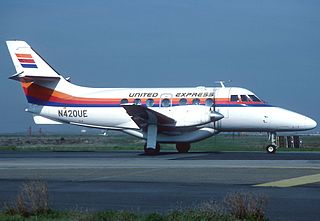
United Express Flight 2415 was a regularly scheduled flight in the northwest United States from Seattle to Pasco, Washington, operated using a BAe Jetstream 31. Late on Tuesday, December 26, 1989, Flight 2415 crashed while attempting to land at Pasco's Tri-Cities Airport, killing both pilots and all four passengers aboard.

Northwest Airlink Flight 2268 was a commuter flight between Cleveland-Hopkins International Airport in Cleveland, Ohio, United States, and Detroit Metropolitan Wayne County Airport in Romulus, Michigan, just outside Detroit. The flight was operated by Fischer Brothers Aviation, doing business as Northwest Airlink, and was operated by a CASA C-212 aircraft. On March 4, 1987, the plane crashed while attempting to land. Nine of the 19 passengers and crew on board were killed in the crash.
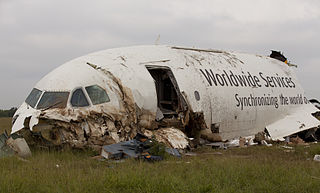
UPS Airlines Flight 1354 (5X1354/UPS1354) was a scheduled cargo flight from Louisville, Kentucky, to Birmingham, Alabama. On August 14, 2013, the Airbus A300 flying the route crashed and burst into flames short of the runway on approach to Birmingham–Shuttlesworth International Airport. Both pilots were pronounced dead at the scene of the crash. They were the only people aboard the aircraft. It was the second fatal air crash for UPS Airlines.

Delta Air Lines Flight 723 was a flight operated by a McDonnell Douglas DC-9 twin-engine jetliner, operating as a scheduled domestic passenger flight from Burlington, Vermont, to Logan International Airport in Boston, Massachusetts, with an intermediate stop in Manchester, New Hampshire. On July 31, 1973, at 11:08 a.m., while on an instrument landing system (ILS) instrument approach into Logan in low clouds and fog, the aircraft descended below the glidepath, struck a seawall, and crashed. 88 of the 89 occupants aboard were killed.

On Friday, January 3, 1992, a Beechcraft 1900 operating CommutAir Flight 4821 crashed into a wooded hillside near Gabriels, New York while conducting an ILS approach to Runway 23 at the Adirondack Regional Airport. The cause of the accident was determined to be pilot error. There were two people killed in the crash, and two survivors.

Trans-Colorado Airlines Flight 2286 was a scheduled domestic passenger flight from Denver, Colorado, to Durango, Colorado, operated for Continental Express by Trans-Colorado Airlines. On January 19, 1988, Flight 2286 crashed onto terrain near Bayfield, Colorado, while on approach to Durango-La Plata County Airport. Out of the seventeen people on board, nine were killed, including both crew members.

On May 21, 2000, a British Aerospace BAe-3101 Jetstream 3101 operated by East Coast Aviation Services crashed into mountainous terrain in Bear Creek Township, Wilkes-Barre, Pennsylvania. The plane was carrying 17 professional gamblers returning home from Caesar's Palace Casino in Atlantic City, New Jersey, along with 2 crew members. It was chartered by Caesar's Palace. All 19 passengers and crews on board were killed on impact. This accident, alongside the accident of Aerocaribe Flight 7831 were the accidents with the most fatalities involving the Jetstream 3101 airliner.
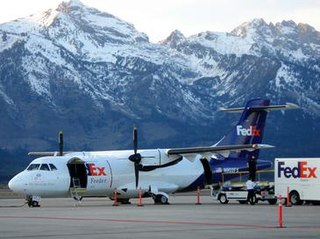
Empire Airlines Flight 8284 was a cargo flight operated by Empire Airlines for FedEx Feeder from Fort Worth Alliance Airport to Lubbock Preston Smith International Airport, Texas. On January 27, 2009, it crashed on final approach to its destination. Both crew members survived with minor injuries but the aircraft was written off.

